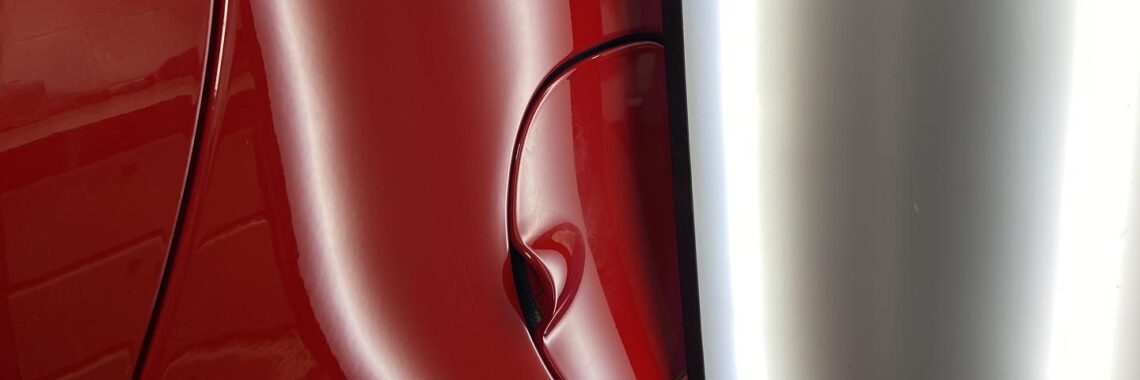
The Complete Guide To Paintless Dent Repair, Everything You Need To Know
When you find a dent in your vehicle, it can be both stressful and frustrating trying to figure out the best way to repair it.
Paintless Dent Repair, also known as PDR, has revolutionised the way we repair vehicle dents, offering a modern solution that preserves your car’s original finish.
As specialists with over 25 years of experience using PDR, we’ve created this article to guide you through everything you need to know about this innovative dent repair method.
From minor door dings to hail damage, understanding your repair options can save you time, and money, and help maintain your vehicle’s value.
Let’s explore how PDR works, what it is, its benefits, and why it might be the perfect solution for your vehicle’s dents.
What is Paintless Dent Repair? (PDR)
Paintless Dent Repair is a specialised automotive repair technique that removes dents and dings from vehicle panels without disturbing the original factory paint finish.
Unlike traditional repair methods, PDR doesn’t require any filling, sanding, or repainting of the damaged area. Instead, skilled technicians use precise tools and techniques to carefully massage the dented metal back to its original position from behind the panel.
This dent repair method has become the preferred choice for many vehicle owners because it preserves the original factory finish, a significant advantage for maintaining your car’s value.
Where is PDR Most Effective?
- Door dings from shopping carts and car parks
- Hail damage across vehicle panels
- Minor dents from low-impact incidents
- Body line creases and shallow depressions
What Is The Difference Between Conventional Repair and Paintless Dent Repair?
The difference between PDR and traditional dent repair methods comes down to the fundamental approach of treating damaged metal. Traditional dent repair is an invasive process that alters your vehicle’s original finish through several steps:
Traditional Dent Repair
- Requires sanding away the original paint
- Uses body filler to reshape the damaged area
- Needs multiple layers of primer
- Involves mixing and applying new paint
- Requires blending with surrounding panels
- Takes several days to complete
- Often costs significantly more
- Risks paint colour mismatches
Paintless Dent Repair
- Preserving the original factory paint finish
- Working with the existing metal panel
- Using specialised tools to reshape the metal
- Maintaining the vehicle’s resale value
- Completing repairs within hours
- Costing less than traditional methods
- Eliminating the risk of paint mismatches
Think of it like this:
traditional dent repair is like covering up damage with new materials, while PDR is like reshaping what’s already there, similar to gradually reshaping a piece of clay back to its original form.
How Does Paintless Dent Repair Work?
Paintless dent repair is a precise, methodical process that requires both skill and specialised equipment.
At its core, PDR works by carefully manipulating the metal from behind the dent to restore its original shape, but let’s break down exactly how this happens.
The PDR Process
1. Assessment and Planning
Before any repair begins, technicians carefully assess the damage by:
- Examining the dent’s location, size, and depth
- Using specialised lighting to see the exact contours of the dent
- Determining the best access points to reach behind the panel
- Planning the most effective repair strategy
2. Accessing The Dent
Getting to the back of the dent often requires:
- Removing interior panels or trim pieces
- Working through existing access points in the vehicle’s body
- Using specialised tools to reach difficult areas
- Sometimes removing lights or other components for better access
3. The Repair Technique
The actual repair process involves:
- Using special LED lighting to create a “shadow board” effect that highlights the dent’s exact shape
- Employing various specialised tools to apply precise pressure to specific points
- Gradually massaging the metal back to its original position
- Working from the centre of the dent toward the outside edges
- Making micro-adjustments to ensure the surface is perfectly smooth
For areas that can’t be accessed from behind, technicians might use a different approach called “glue pulling,” which involves:
- Attaching special adhesive tabs to the dent’s surface
- Using pulling tools to gradually work the dent outward
- Finishing with traditional PDR techniques for a perfect finish
4. Quality Checking and Finishing
The final stage includes:
- Checking the repair under various lighting conditions
- Ensuring the panel is perfectly level
- Verifying that the paint hasn’t been compromised
- Cleaning and inspecting the repaired area
- Reinstalling any removed components
What are The Benefits of Paintless Dent Removal?
When it comes to addressing vehicle dents, PDR offers several compelling advantages:
Preserves Original Paint
Your vehicle’s factory finish remains intact throughout the entire repair process. This is crucial for maintaining your car’s value and appearance, as factory paint is always superior to any refinishing work.
Cost-Effective Solution
PDR typically costs 40-60% less than traditional repair methods because there are:
- No need for paint or materials
- Reduced labor time
- No paint matching required
- Often falls below insurance deductibles
Quick Turnaround
Most repairs are completed within a few hours, meaning you can:
- Get your car back the same day
- Avoid rental car costs
- Return to your routine quickly
- See immediate results
Environmentally Friendly
The process is remarkably eco-conscious as it:
- Uses no harmful chemicals
- Produces no waste materials
- Requires no new resources
- Creates no toxic byproducts
Maintain Vehicle Value
Keeping your car’s original finish intact helps preserve its resale value by:
- Maintaining factory originality
- Avoiding auto history reports
- Preventing potential rust issues
- Preserving structural integrity
What are The Disadvantages of Paintless Dent Repair?
While PDR is an excellent repair method, it does have some limitations:
Not Suitable for All Damage
PDR isn’t effective when:
- Paint is cracked or scratched
- Metal is severely stretched
- Dents are extremely sharp or deep
- Damage extends to panel edges
Access Limitations
Some repairs may be challenging or impossible when:
- Dents are in difficult-to-reach areas
- Panel construction blocks tool access
- Multiple panel reinforcements are present
- Complex panel shapes restrict movement
Results Vary By Technician
The quality of repair depends heavily on:
- Technician skill level
- Years of experience
- Tool quality and selection
- Understanding of metal properties
Is Your Dent Suitable for Paintless Dent Repair?
When it comes to paintless dent repair, size isn’t the only factor that determines whether a dent can be fixed. Let’s explore what makes a dent suitable for PDR and what limitations exist.
How Big of a Dent Can PDR Fix?
Contrary to common belief, PDR can effectively repair dents ranging from tiny door dings to damage as large as a dinner plate. The key factors that determine repair success are:
Dent Depth
- Shallow to medium dents are typically repairable
- Deeper dents may be fixable if the metal isn’t stretched
- Gradual depressions are easier to repair than sharp, deep dents
Paint Condition
The original paint must be:
- Intact with no cracks
- Free from scratches
- Not chipped or peeling
- Not previously repaired
Metal Condition
The metal panel should be:
- Not creased or kinked
- Free from previous repairs
- Not stretched beyond its limit
- Away from panel edges
Common Repairable Dent Types
PDR is particularly effective for:
- Door dings from car parks
- Round dents from hail damage
- Shallow creases from minor impacts
- Body line dents
- Hood and roof depressions
When PDR Might Not Be Suitable
Some situations where alternative repair methods may be necessary:
- Dents with sharp creases or folds
- Damage near panel edges
- Areas with previous bodywork
- Dents with compromised paint
- Damage to plastic panels
Frequently Asked Questions About Paintless Dent Repair
Let’s address some of the most common questions about PDR to help you better understand the process and what to expect.
Can Dents Come Back After PDR?
No, when PDR is performed correctly, dents will not return. Once the metal is properly restored to its original position, it remains stable. However, it’s important to note:
- The repair must be done by a skilled technician
- The metal needs to be properly worked back to its original state
- The repair area is just as strong as the rest of the panel
- The same spot can be dented again if impacted
Does PDR Cover Scratches?
PDR specifically addresses dents and dings in the metal panels and:
- Cannot repair paint scratches
- Won’t fix paint scuffs or chips
- Doesn’t address paint peeling
- May need to be combined with paint touch-up services if scratches are present
How Long Does PDR Take?
The repair time varies depending on several factors:
- Most small dents take 1-2 hours
- Larger dents might require 2-3 hours
- Multiple dents or hail damage may take several hours
- Complex repairs might need a full day
- Location and access to the dent affect repair time
Is PDR Safe for My Vehicle?
Yes, PDR is completely safe when performed correctly:
- No structural integrity is compromised
- The original metal strength remains intact
- Factory paint protection stays in place
- No risk of rust or corrosion issues
What About Insurance and PDR?
PDR often works favourably with insurance because:
- Costs are typically lower than traditional repairs
- Many repairs fall under standard deductibles
- Insurance companies often prefer PDR
- No impact on vehicle history reports
How Long Do PDR Repairs Last?
PDR repairs are permanent and will last the lifetime of your vehicle, provided:
- The repair was completed correctly
- No new damage occurs in the same area
- The original metal wasn’t overly stressed
- Factory paint wasn’t compromised
Why Choose Expert PDR for Your Vehicle Dents?
As we’ve explored throughout this guide, paintless dent repair offers a modern, efficient, and cost-effective solution for vehicle dent repair. The key to successful PDR lies not just in the method itself, but in choosing skilled technicians who understand the intricacies of working with your vehicle’s panels.
Professional PDR provides:
- A cost-effective repair solution
- Preservation of your vehicle’s original finish
- Quick turnaround times
- Long-lasting results
- Environmentally friendly repairs
When considering PDR for your vehicle’s dents, working with experienced professionals ensures the best possible outcome for your repair.
Ready to restore your vehicle’s appearance?
With over 25 years of specialised experience in paintless dent removal, We are Cheshire’s trusted expert in PDR. Our skilled technicians are ready to assess your vehicle’s damage and provide professional repair solutions.
Speak to an expert today!
- Call: 07398 022313
- Email: info@dentsinc.co.uk
- On the website
Most repairs can be completed within 1-2 hours, and we pride ourselves on delivering exceptional results backed by over 300 5-star Google reviews.
